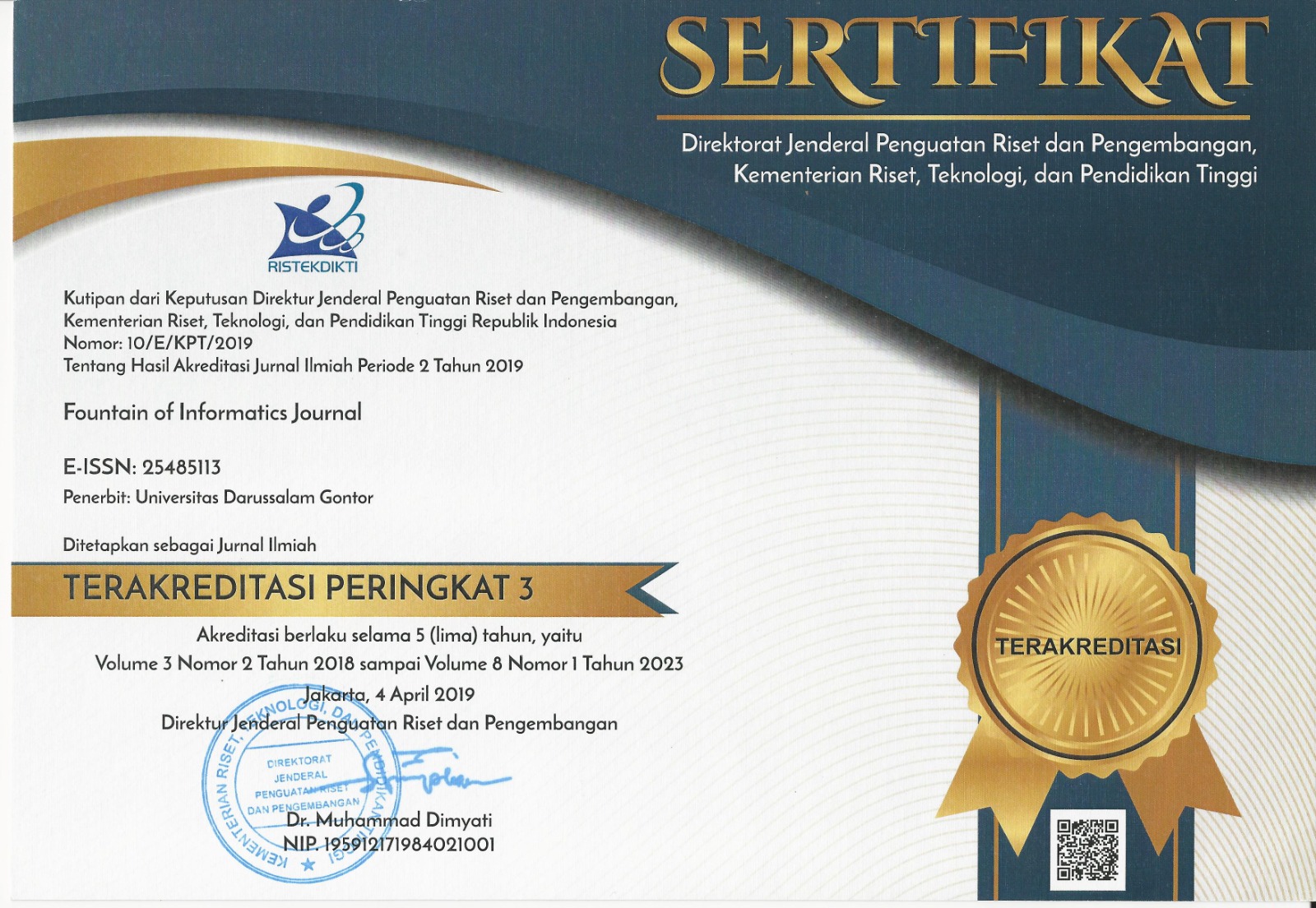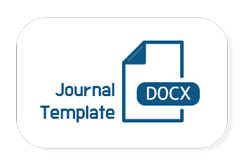Perancangan Information System Architecture Menggunakan Togaf Adm Pada Fungsi Promosi (Studi Kasus: Dinas Pariwisata dan Kebudayaan Pemerintah Kabupaten Bandung Barat)
DOI:
https://doi.org/10.21111/fij.v5i1.3312Keywords:
SPBE, Enterprise Architecture, TOGAF ADM, GSBAbstract
AbstrakUntuk mematuhi Peraturan Presiden No. 95 Tahun 2019 tentang Sistem Pemerintahan Berbasis Elektronik(SPBE), Pemerintah Kabupaten Bandung Barat harus mampu menyelaraskan layanan bisnis dengan teknologi informasi yang ada, khususnya pada fungsi promosi Dinas Pariwisata dan Kebudayaan. Enterprise Architecture merupakan salah satu metode yang dapat digunakan untuk menyelaraskan strategi bisnis dengan teknologi informasi dan mendukung program SPBE. Dalam melakukan perancangan EA dibutuhkan framework arsitektur untuk mengembangkan lingkup pembahasan secara luas dari sisi bisnis, aplikasi, data, dan teknologi. Framework yang digunakan pada perancangan ini adalah TOGAF ADM yang terdiri dari 9 fase. Pada penelitian ini, peneliti mengambil studi kasus pada Fungsi Promosi dengan menjadikan Government Service Bus (GSB) sebagai teknologi utama. Enterprise Architecture yang diharapkan dapat mempermudah pencapaian tujuan strategis, peningkatan proses bisnis, sistem informasi, dan teknologi informasi yang digunakan. Dari penelitian ini akan dihasilkan output berupa cetak biru dari rancangan enterprise architecture fase information system pada fungsi promosi Dinas Pariwisata dan Kebudayaan. Penilitian ini dapat menjadi referensi untuk pengembangan lebih lanjut hingga fase change management architecture.Kata kunci: SPBE, Enterprise Architecture, TOGAF ADM, GSB Abstract[Information System Architecture Analysis and Design Using TOGAF ADM in Promotion Function (Case Study: Department of Tourism and Culture in Bandung Barat Government)]. To approve Presidential Regulation No. 95 of 2019 concerning Electronic Based Government Systems (SPBE), the Government of West Bandung Regency must provide aligning business services with existing information technology, specifically in the promotion function of the Office of Tourism and Culture. Company architecture is one method that can be used to align business strategies with information technology and support the SPBE program. In designing an EA, an architectural framework is needed to develop broader, business, application, data and technology approvals. The framework used in this design is TOGAF ADM which consists of 9 phases. In this study, researchers took a case study on the Promotion Function by making the Government Service Bus (GSB) the main technology. The company architecture is expected to achieve strategic objectives, business process improvement, information systems, and information technology used. This research will produce output in the form of a blueprint of the architecture of the enterprise information system phase of the promotion of the Department of Tourism and Culture. This research can be a reference for further development until the phase of management architecture change TOGAF ADM.Keywords: SPBE, Enterprise Architecture, TOGAF ADM, GSBÂReferences
[1] UNDESA, “2018 UN E-Government Survey,†United Nations E-Government Surv. 2018, 2018.[2] TOGAF, “The TOGAF® Standard, Version 9.2,†TOGAF Libr., pp. 33–34, 2018.[3] I. G. Mindrayasa, S. T. Murahartawaty, and R. H. S. T, “Analisis dan Perancangan Data Architecture dan Application Architecture Menggunakan The Open Group Architecture Framework Architecture Development Method ( TOGAF ADM ) pada PT . Shafco Multi Trading,†Jurnal Rekayasa Sistem & Industri., vol. 2, no. 2, pp. 5737–5741, 2015.[4] S. Kotusev, “Different Approaches to Enterprise Architecture,†J. Enterp. Archit., vol. 12, no. 4, pp. 9–16, 2016.[5] S. Kotusev, “Enterprise Architecture: What Did We Study?,†Int. J. Coop. Inf. Syst., vol. 26, no. 04, p. 1730002, 2017.[6] S. Kotusev, “Two Worlds of Enterprise Architecture,†no. August 2016, 2016.[7] Da Silva, N. M. C., Da Silva, M. L. B. M., & De Sousa, P. M. V. A. (2017). “A Viewpoint for Analyzing Enterprise Architecture Evolutionâ€. Proceedings - 2017 IEEE 21st International Enterprise Distributed Object Computing Conference, EDOC 2017, 2017–Janua, 20–29.[8] K. Ghozali, “Comparative Study of E-Government Enterprise Architecture by Primary Attributes of 3 Asian Countries,†Journal of Information Systems., vol. 8, no 2, pp. 69–73, 2012[9] Shaanika, I., & Iyamu, T. (2018). “Developing the enterprise architecture for the Namibian government.†Electronic Journal of Information Systems in Developing Countries, 84(3), 1–11.[10] Agus, “Kementerian Pendayagunaan Aparatur Negara dan Reformasi Birokrasi - Inpassing PNS Berdasarkan Angka Kredit,†2016.[11] Peraturan Presiden RI, “Sistem Pemerintahan Berbasis Elektronik,†p. Nomor 95 Tahun 2018, 2018.[12] Wißotzki, M., & Sandkuhl, K. (2014). “The Practice of Enterprise Modeling,†Springer International Publishing AG 2017, 197, 352–362.[13] A. A. M. Al-Ghamdi and F. Saleem, “Enterprise application integration as a middleware: Modification in data & process layer,†Proc. 2014 Sci. Inf. Conf. SAI 2014, no. August 2014, pp. 698–701, 2014.[14] M. K. Hettinger and M. Consulting, “Enterprise Application Integration : Integration and Utilization of SAS Products.â€[15] G. Flurry, “Enterprise Service Bus,†Encycl. Database Syst., pp. 1–4, 2016.[16] W. H. Utomo, “Penerapan Enterprise Service Bus (ESB) Sebagai Middleware Integrasi Berbasis SOA,†Semin. Nas. Teknol. Inf. dan Komun. 2012, vol. 2012, no. Sentika, pp. 85–91, 2012.[17] Buku Pedoman Manajemen Integrasi Informasi dan Pertukaran Data (Vol. 3), vol. 3, no. c. . [18] Dhingra, M. (2017). “Enterprise Information Security Architectures.†Ijser.Org, 8(3), 766–769.
Downloads
Submitted
Accepted
Published
Issue
Section
License
Please find the rights and licenses in the Fountain of Informatics Journal (FIJ). By submitting the article/manuscript of the article, the author(s) agree with this policy. No specific document sign-off is required.
1. License
The non-commercial use of the article will be governed by the Creative Commons Attribution license as currently displayed on Creative Commons Attribution-NonCommercial-ShareAlike 4.0 International License.Â
2. Author(s)' Warranties
The author warrants that the article is original, written by the stated author(s), has not been published before, contains no unlawful statements, does not infringe the rights of others, is subject to copyright that is vested exclusively in the author, and free of any third party rights, and that any necessary written permissions to quote from other sources have been obtained by the author(s).
3. User/Public Rights
FIJ's spirit is to disseminate articles published are as free as possible. Under the Creative Commons license, FIJ permits users to copy, distribute, display, and perform the work for non-commercial purposes only. Users will also need to attribute authors and FIJ on distributing works in the journal and other media of publications. Unless otherwise stated, the authors are public entities as soon as their articles got published.Â
4. Rights of Authors
Authors retain all their rights to the published works, such as (but not limited to) the following rights;
- Copyright and other proprietary rights relating to the article, such as patent rights,
- The right to use the substance of the article in own future works, including lectures and books,
- The right to reproduce the article for own purposes,
- The right to self-archive the article (please read out deposit policy),
- The right to enter into separate, additional contractual arrangements for the non-exclusive distribution of the article's published version (e.g., post it to an institutional repository or publish it in a book), with an acknowledgment of its initial publication in this journal (Jurnal Optimasi Sistem Industri).
5. Co-Authorship
If the article was jointly prepared by more than one author, any authors submitting the manuscript warrants that he/she has been authorized by all co-authors to be agreed on this copyright and license notice (agreement) on their behalf, and agrees to inform his/her co-authors of the terms of this policy. FIJ will not be held liable for anything that may arise due to the author(s) internal dispute. FIJ will only communicate with the corresponding author.
6. Royalties
Being an open accessed journal and disseminating articles for free under the Creative Commons license term mentioned, author(s) aware that FIJ entitles the author(s) to no royalties or other fees.Â
7. Miscellaneous
FIJ will publish the article (or have it published) in the journal if the article’s editorial process is successfully completed. FIJ's editors may modify the article to a style of punctuation, spelling, capitalization, referencing, and usage that deems appropriate. The author acknowledges that the article may be published so that it will be publicly accessible and such access will be free of charge for the readers as mentioned in point 3.










